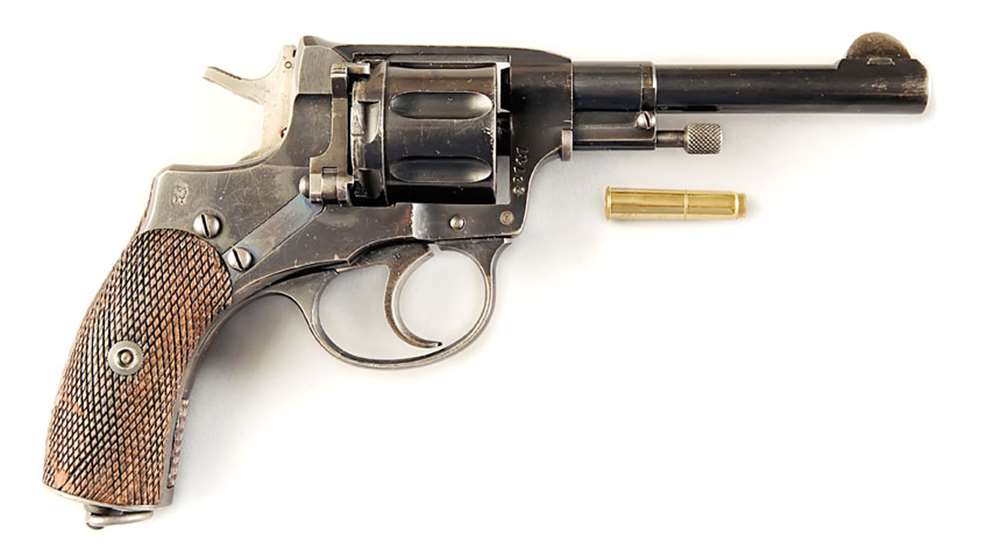
In the third quarter of the 19th century, Leon and Emil Nagant of Liege, Belgium, began making something of a name for themselves in the revolver field—the brothers’ double-action designs being recognized for their modest, but eminently practical, innovations.
In order for a revolver to work properly and efficiently, there has to be a reasonable amount of clearance between the rear of the barrel and the cylinder face. Unfortunately, this gap causes an escape of gas resulting in some power loss. As far back as the flintlock era, inventors came up with contrivances to correct this perceived shortcoming—normally relying on some sort of physical cover over the space or a reciprocating cylinder arrangement. Fortunately, the introduction of the self-contained metallic cartridge made the problem a bit easier to rectify.
In 1892, Leon Nagant introduced a unique gas-seal system which, when his revolver’s hammer was cocked, activated a mechanism that moved the cylinder forward, causing a milled-out, recessed forward portion of each of the seven chambers to enclose the tapered rear of the barrel. This worked in conjunction with a special cartridge in which the bullet was seated deeply into the case permitting the undersized, slightly crimped case mouth to snug up inside of the rear of the barrel cone to provide almost perfect obturation.
Nagant had worked with the Imperial Russians earlier, providing a feature that was incorporated in the Model 1891 Mosin-Nagant “Three-Line” rifle. His contribution, though arguably minimal, gave him an “in” with czarist ordnance types, who took a shine to his new revolver. They liked it so much, in fact, that in 1895 it was adopted as the country’s primary sidearm, replacing the rather long-in-the-tooth Smith & Wesson No. 3 “Russian” top-break single-action.

The mechanics required to make Nagant’s 1895 revolver operate properly, while not exactly simple, were hardy and reliable. Provided in single- and double-action versions (for other ranks and officers, respectively), the revolver was built on a solid frame. Spent cases were ejected singly via an under-barrel, swiveling rod. While the 7.62x38 mm R cartridge’s 108-gr. flat-nose bullet lacked gravitas, its 1000 f.p.s. muzzle velocity boosted stopping power. It was reckoned by some that the gas seal contributed an additional 50-70 f.p.s. to the bullet’s speed.
Because of the gas-seal system, the revolver’s double-action trigger pull was quite heavy. The movement of the cylinder also necessitated an abnormally long firing pin, which was pinned to the hammer to allow enough movement to align it properly with the cartridge primer.
Initially manufactured in Belgium, in 1899 the ’95’s production was transferred to Tula Arsenal in Russia, the Russians having bought all rights and tooling from Nagant. The gun’s finish was blue, and stocks were checkered walnut.
Even after the Soviet takeover of Russia, the Model 1895 Nagant continued in service. Though technically replaced in 1930 by the TT-30 “Tokarev” semi-automatic pistol, the ’95 continued to be made and used throughout World War II, with production undertaken at Tula and other plants.
Before the fall of the Soviet Union, good-condition Model 1895 Nagants were a bit hard to come by in the collector market. Since then, importation of thousands of them—many refurbished—have made the guns readily available and relatively inexpensive.
Still, early, unaltered, good-condition specimens without importer’s marks, such as the one we’re looking at here, are a bit on the scarce side. As such, this one is worth $650.
Gun: Model 1895 Nagant
Manufacturer: Tula Arsenal
Chambering: 7.62x38 mm R Nagant
Manufactured: 1914
Condition: NRA Excellent (Antique Gun Standards)
Value: $650




































